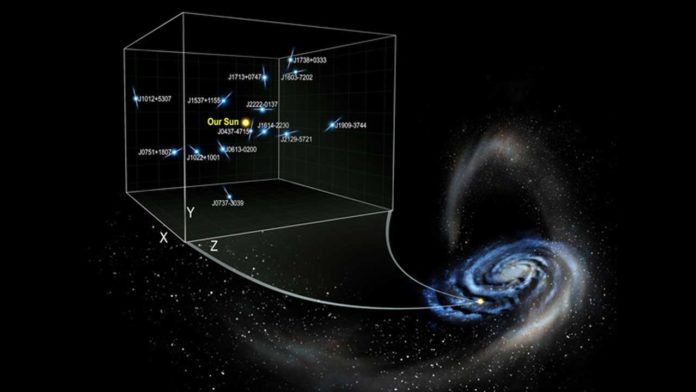In a new study, scientists obtained the first direct measurement of the average acceleration in our home galaxy, the Milky Way. Using pulsar data, scientists clocked the radial and vertical accelerations of stars within and outside the galactic plane.
Based on these new high-precision estimations and the known measure of visible matter in the universe, analysts were then able to calculate the Milky Way’s dark matter density without making the usual assumption that the galaxy is in a steady-state.
Sukanya Chakrabarti at the Institute for Advanced Study said, “Our analysis not only gives us the first measurement of the tiny accelerations experienced by stars in the galaxy but also opens up the possibility of extending this work to understand the nature of dark matter and ultimately dark energy on larger scales.”
Stars plunge through the system at hundreds of kilometers every second. Yet, this investigation demonstrates that the change in their velocities occurs at a literal snail’s pace—a few centimeters for each second, which is about the same speed as a crawling baby. To distinguish this subtle motion, the examination group depended on the ultraprecise time-keeping ability of pulsars that are broadly dispersed throughout the galactic plane and halo. This diffuse spherical region encompasses the galaxy.
Co-author Philip Chang of the University of Wisconsin-Milwaukee said, “By exploiting the unique properties of pulsars, we were able to measure tiny accelerations in the Galaxy. Our work opens a new window in galactic dynamics.”
The Milky Way’s galactic halo accounts for about 90 percent of the galaxy’s mass and is highly concentrated above and below the star-dense galactic plane.
Stellar motion in this specific region—a primary focus of this investigation—can be affected by dark matter. Utilizing the local density measurements obtained through this study, researchers will now have a better idea of how and where to look for dark matter.
By accounting for the “ripples,” the team could obtain a more accurate picture of reality. Though in this case, rather than stones, the Milky Way is influenced by the turbulent history of galactic mergers and continues to be perturbed by external dwarf galaxies like the Small and Large Magellanic Clouds.
As a result, stars do not have flat orbits and tend to follow a path similar to that of a warped vinyl record, crossing above and below the galactic plane. One of the critical factors that enabled this direct observational approach was using pulsar data compiled from international collaborations, including NANOGrav that has obtained data from the Green Bank and Arecibo telescopes.
Scott Tremaine, Professor Emeritus at the Institute for Advanced Study, said, “For centuries astronomers have measured the positions and speeds of stars, but these provide only a snapshot of the complex dynamical behavior of the Milky Way galaxy. The gravitational forces directly cause the accelerations measured by Chakrabarti and her collaborators from the matter in the galaxy, both visible and dark, and thereby provide a new and promising window on the distribution and the composition of the matter in the galaxy and the universe.”
Astronomers noted, “This particular paper will enable a wide variety of future studies. Accurate measurements of accelerations will also soon be possible using the complementary radial velocity method. This work will also enable more detailed simulations of the Milky Way, improve general relativity constraints, and provide clues in the search for dark matter. Extensions of this method may ultimately allow us to measure the cosmic acceleration as well directly.”
Journal Reference:
- Sukanya Chakrabarti et al. A measurement of the Galactic plane mass density from binary pulsar accelerations. arXiv:2010.04018 [astro-ph.GA]
